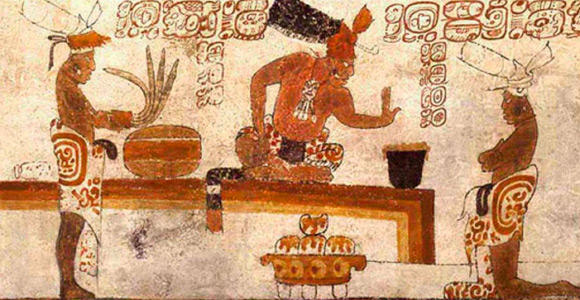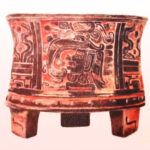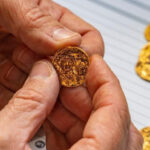Cacao, known as the money that grew on trees and as a food from the gods, was brought to the world stage by ancient Mesoamericans. The historical background and prehistory of cacao, particularly for the Maya, has been imbued with ceremony and luxury. Past efforts to identify cacao in ceramics focused on highly decorative vessel forms associated with elite ceremonial contexts, creating assumptions as to how cacao was distributed and who could access it. In new research, scientists at the University of California, Santa Barbara, examined 54 archaeological ceramic sherds from residential and civic contexts in El Pilar, located between Belize and Guatemala, representing a cross-section of ancient Maya inhabitants. Their results show that cacao was widespread and found in civic and residential units regardless of size and location.
Painted cylinder vase depicting a foaming drink in a vase and tamales in a plate. Image credit: Justin Kerr, mayavase.com, Kerr number: 6418 (88).
“It had long been assumed that cacao for the Maya was an elite exclusive,” said Dr. Anabel Ford, an anthropologist and director of the MesoAmerican Research Center at the University of California, Santa Barbara.
“We now know this is not the case. The imbibing of cacao was a luxury accessible to all. The importance is that it was a requirement of the rituals associated with it.”
To test the exclusivity of cacao use, Dr. Ford and colleagues examined 54 archaeological ceramic sherds.
Originating from El Pilar, the sherds can be traced to Late Classic period civic and residential contexts (600 to 900 CE), representing a cross section of ancient Maya inhabitants.
The study included a chemical analysis of these sherds — specifically of the biomarkers for cacao: caffeine, theobromine and theophylline.
“The discovery of chemical signatures of cacao made the investigation possible, but the main active ingredient, theobromine, it turns out is not sufficiently discrete to be certain of the cacao attribution,” Dr. Ford said.
In their selection of ceramics to test, the authors prioritized the vases from which cacao was likely drunk.
They also tested bowls, jars and plates. All vessel types had evidence of cacao.
“This was a surprise at first, but giving thought to the presence and understanding of their uses, bowls would be good for mixing, jars would be right for warming the drink (a traditional cacao preparation) and plates appropriate for serving food with sauces that can contain cacao (such as mole poblano),” Dr. Ford said.
“Now that we know that the presence of cacao is in all vessel types, we need to understand the greater distribution and use of these important household forms.”
“What is critical in our work is that the data I collected in the El Pilar-Belize River area emphasizes the ordinary households and not just the elite center.”
“Our research thus breaks ground on the identification and the distribution.”
The study was published in the Proceedings of the National Academy of Sciences.
_____
Anabel Ford et al. 2022. New light on the use of Theobroma cacao by Late Classic Maya. PNAS 119 (40): e2121821119; doi: 10.1073/pnas.2121821119




